Available Radiotracers
PET Radiotracers Available at CMGI
PET uses [18F]- or [11C]-substituted analogs of small molecules that are involved in biochemical processes to image tissue perfusion, metabolism, drug/receptor interactions, and gene expression in vivo. For example, [18F]Fluorodeoxyglucose, an analog of glucose, is used to image areas of high metabolism, such as rapidly proliferating tumors. Targeting molecules may also be covalently conjugated to a metal binding chelating agent, such as TETA or desferrioxamine, to be radiolabeled with 64Cu or 89Zr, respectively, for PET imaging.
18F- and 11C-PET tracers routinely available, and typical quantities available:
- [18F]FLT, [18F]FHBG, [18F]FMISO, and [18F]PBR111 (each >100 mCi)
- [18F]FBA and [18F]SFB (for peptide labeling; >500 mCi)
- [11C]Raclopride, [11C]SCH23390, and [11C]PK11195 (each >15 mCi)
- [18F]FDG (0.5-15 mCi)
Click here for a price list.
|
 [18F]Fluoride [18F]Fluoride
[18F]Fluoride in aqueous solution is used primarily to image bone and therefore can provide information on features of the skeleton.
Half life 110 minutes; available daily.
|
 [18F]FDG [18F]FDG
[18F]Fluorodeoxyglucose, one of the most commonly used PET tracers, is used to measure tissue glucose metabolism. It has important diagnostic and research applications in oncology, neurology, and cardiology.
Half life 110 minutes; available daily.
|
|
 [18F]FHBG [18F]FHBG
9-(4-[18F]Fluoro-3-hydroxymethylbutyl) guanine is a reporter probe for the herpes simplex virus type 1 thymidine kinase (HSV1-tk) gene, which is transfected into malignant cells in experimental suicide gene therapy.
Half life 110 minutes; available daily.
|
 [18F]FLT [18F]FLT
[18F]Fluorothymidine is a marker for cell proliferation that is more selective for tumor imaging than [18F]FDG.
Half life 110 minutes; available daily.
|
|
 [18F]FMISO [18F]FMISO
[18F]Fluoromisonidazole is used for the detection of hypoxia in tumors, myocardial infarcts, or cerebral ischemia.
Half life 110 minutes; available daily.
|
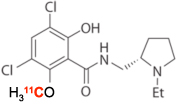 [11C]Raclopride [11C]Raclopride
[11C]Raclopride is a widely used PET tracer for measurement of D2 dopamine receptor binding characteristics.
Half life 20 minutes; available daily.
|
|
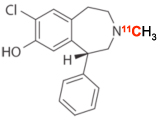 [11C]SCH23390 [11C]SCH23390
[11C]SCH23390 is used to measure D1 dopamine receptor binding characteristics.
Half life 20 minutes; available daily.
|
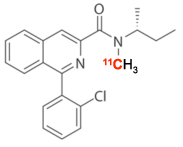 [11C]PK11195 [11C]PK11195
[11C]PK11195 is used to measure microglial activation, associated with various neurodegenerative and neuroinflammatory diseases.
Half life 20 minutes; available daily.
|
|
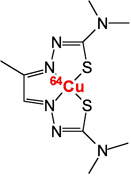 [64Cu]Cu-PTSM [64Cu]Cu-PTSM
[64Cu]Cu-pyruvaldehyde-bis[N4-methylthiosemicarbazone] is a tracer for blood flow, hypoxia, and cell binding studies.
Half life 12.7 hours; available every two weeks. Please inquire for specific dates.
Novel Radiochemistry and Custom Synthesis
4-[18F]fluorobenzoic acid (FBA) and 2-[18F]fluoropropionic acid (FPA) are used as building blocks for the synthesis of complex molecules such as [18F]-fluoropaclitaxel and as a prosthetic groups for the labeling of peptides and proteins. The synthesis of FBA has been automated.
Peptides may be site-specifically radiolabeled in the solid phase with 18F via FBA or FPA. In cases where solution-phase labeling is preferred, Cu catalyzed 1,3-dipolar Huigen’s cycloaddition (“click” chemistry) is used. Peptides may also be conjugated to a chelating (metal binding) agent for radiolabeling with 64Cu or 89Zr. (Shown below) |

64Cu- and 89Zr-labeled proteins, peptides, and high MW probes (above)
Relatively long-lived 64Cu (half life 12.7 hours) and 89Zr (78.4 hours) are well matched to the longer uptake and residence times of higher molecular weight probes such as antibodies, peptides, and nanoparticles.
[64Cu]Cu-TETA-conjugates
(shown):The molecular probe is conjugated to the chelating (metal binding) agent TETA, which binds 64Cu.
Half life 12.7 hours; available every two weeks. Please inquire for specific dates.
[89Zr]Zr-desferal-conjugates
The molecular probe is conjugated to the chelating agent desferrioxamine, which binds 89Zr.
Half life 78.4 hours; available weekly.
|

Solid phase peptide labeling using 4-[18F]fluorobenzoic acid (FBA).
|
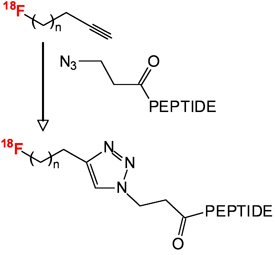
“Click” chemistry for radiolabeling of peptides with [18F]fluoroalkynes.
|











